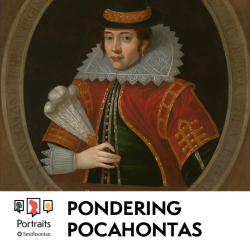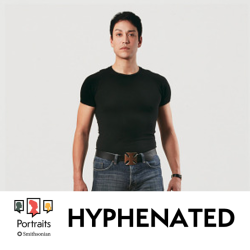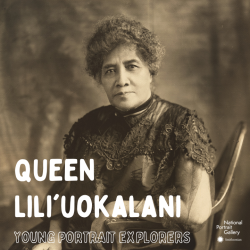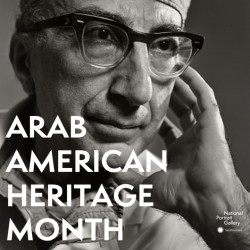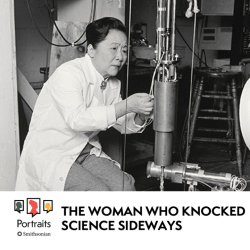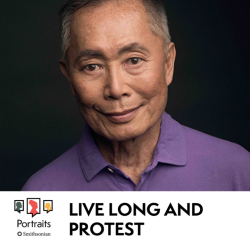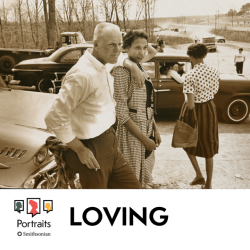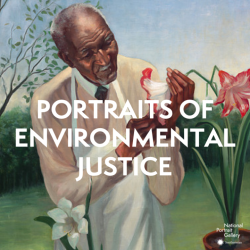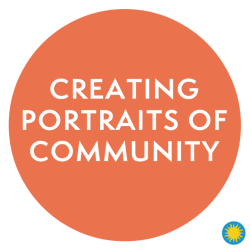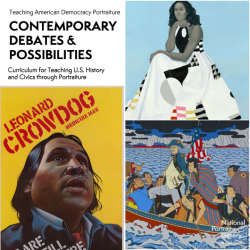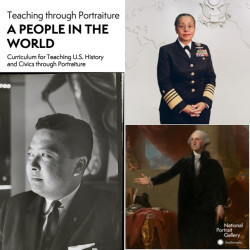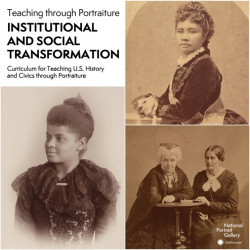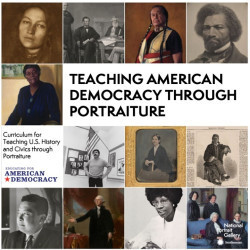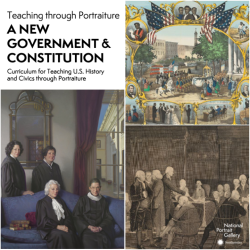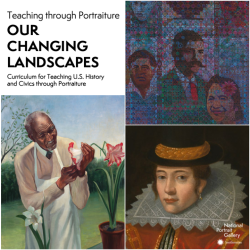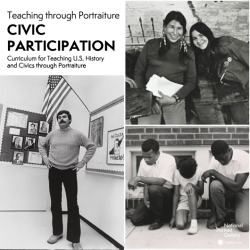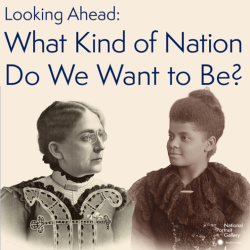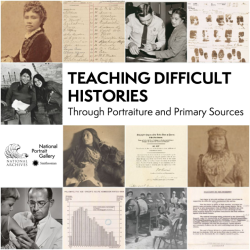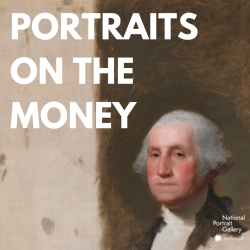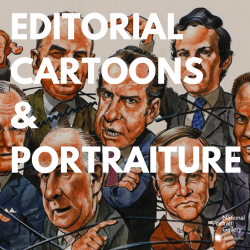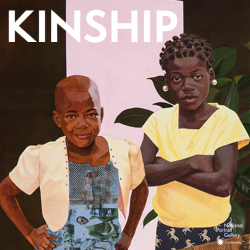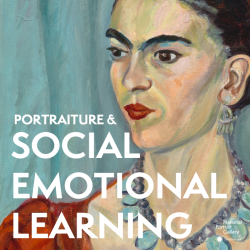Nicole Vance's collections
PORTRAITS Podcast: Pondering Pocahontas
<p>In this collection, students will be better able to identify key elements of a portrait and discuss what we can learn about the sitter through these elements. They will also investigate how these elements may reveal the viewpoints of artist, sitter, and viewer while practicing media literacy skills. </p>
<p>This lesson was written by Erin Koester Tusell, Gallery Educator at the National Portrait Gallery.</p>
 Nicole Vance
Nicole Vance
27
PORTRAITS Podcast: Hyphenated - The Intersect of Asian-American Stories in the United States
<p>In this lesson, students will analyze historical contexts through the exploration of portraiture, discuss the artistic choices that portrait artists make and consider how such decisions can reveal the artists’ viewpoints and influence the viewers’ understanding of the sitters’ identity. </p>
<p>This lesson was written by Asia Stanislaus, a member of the National Portrait Gallery's Teacher Advisory Board, who teaches at MS 447 in Brooklyn, New York.</p>
 Nicole Vance
Nicole Vance
28
Queen Lili'uokalani: Young Portrait Explorers
<p>Learn about Queen Lili'uokalani and decorate sheet music of "Aloha Oe" with Hawaiian flowers. </p>
<p>This lesson was created by National Portrait Gallery educators Beth Evans and Irina Rubenstein.</p>
<p>#NPGteach</p>
 Nicole Vance
Nicole Vance
26
PORTRAITS Podcast: Loving
<p>In this lesson, students will learn about historical taboos around relationships and race in the United States using a portrait of Richard and Mildred Loving. They will analyze contemporary societal norms around relationship diversity along ethnic, religious, and/or class lines.</p>
<p>This lesson plan was written by NPG Teen Programs Specialist, Sahtiya H. Hammell.</p>
 Nicole Vance
Nicole Vance
19
PORTRAITS Podcast: On the Beat
<p>In this lesson, students will analyze the power of perspective, reflect on "drawn journalism" as portraits, and engage in meaning making around objects in their lives using portraits by artist Wendy McNaughton.<br></p>
<p>This lesson plan was written by NPG Teen Programs Specialist, Sahtiya H. Hammell.</p>
 Nicole Vance
Nicole Vance
24
Portraits of Environmental Justice
<p>What is our relationship to the rest of the natural world, and what are our responsibilities toward it? How do scientific, political, social, economic, aesthetic, and moral considerations factor into our decisions? In this collection learn about key people—scientists, politicians, activists, writers, and artists—whose work has influenced attitudes toward the environment in the United States.</p>
<p>This collection includes portraits from <a href="https://npg.si.edu/exhibition/forces-nature-voices-shaped-environmentalism-0"></a><em><a href="https://npg.si.edu/exhibition/forces-nature-voices-shaped-environmentalism-0">Forces of Nature: Voices that Shaped Environmentalism</a></em> on view at the National Portrait Gallery October 20, 2023 - September 2, 2024.</p>
 Nicole Vance
Nicole Vance
97
Teaching American Democracy through Portraiture: Institutional and Social Transformation
<p>In this Learning Lab collection, portrait photography of nineteenth century women including Susan B. Anthony, Elizabeth Cady Stanton, Queen Lili'uokalani, and Ida B. Wells are used as entry points to teach about institutional and social transformation. Throughout this collection, students will examine not only the portrait subjects but will also gain insight into the larger historical time period in which the subjects lived and how they navigated and made change in their communities and the United States.<br></p>
<p>This collection contains three lessons that highlight activists: "Reading Portraiture: Women’s Suffrage in 3D," "Primary Perspectives on Hawaii," and "Connections to the Present: Changemaker Conversations."</p>
<p>Review Reading Portraiture 101 before beginning the lessons.</p>
<p>#NPGteach #EducatingForDemocracy</p>
 Nicole Vance
Nicole Vance
46
Teaching American Democracy through Portraiture
<p>This Learning Lab complements, "Educating for American Democracy" a roadmap for excellence in history and civics featuring portraits from 1600 to today. The portraits are used as entry points to teach about the history of the United States and civic values. This collection serves as a home base, organizing the following components: (1) Background Essay and Timeline; (1) About Educating for American Democracy; (2) Reading Portraiture 101; (3) Seven Themes: Lesson Plan; (4) Design Challenges: Artmaking Prompts.</p>
<p>Throughout these Learning Lab collections, students will examine not only the portraits’ subjects and artists but will also gain insight into the larger historical time period in which the subjects lived. By studying the portraits, students will be able to understand how the sitters in these portraits exercised agency and explored civic themes. </p>
<p>Educators will come to this Learning Lab collection from a wide range of disciplines and grade levels and can use the activities and resources as they see fit. The materials have been developed toward middle school social studies classes to allow teachers to scaffold lessons and add extension activities as needed. This Learning Lab collection was designed to be integrated with flexibility. It can be used in order, as single-time activities, or in various combinations to support existing topics in the curriculum.</p>
<p>#NPGteach</p>
 Nicole Vance
Nicole Vance
19
Teaching American Democracy through Portraiture: We the People
<p>In this Learning Lab collection, portraits are used entry point to teach about citizens and residents of the United States. Throughout this collection, students will examine not only the portrait subjects but will also gain insight into the larger historical time period in which the subjects lived and how they made change in their communities and the United States.</p>
<p>This collection contains three lessons that highlight the many people, ideas, and cultures of the United States: "Reading Portraiture:</p>
<p>Same, Different, Connect, Engage," "Engaging History: Expanding Democracy," and "Connections to the Present: Reading Election Posters."</p>
<p>Review Reading Portraiture 101 before beginning the lessons.</p>
<p>#NPGteach #EducatingForDemocracy</p>
 Nicole Vance
Nicole Vance
54
Looking Ahead: What Kind of Nation Do We Want to Be?
<p>How can the past inform our future? Imagine you are living in the U.S. in 1899. In this era of rapid expansion and increasing tensions many Americans are asking "what kind of nation do we want to be?" Across the United States, people are talking about what that means for themselves and for their country. For this lesson, students will imagine they are gathered in an issue forum. This guide is meant to provide a framework for student deliberation by offering three approaches to the complex question: "what kind of nation do we want to be?" Each option is accompanied by possible actions to be taken and notes possible drawbacks.</p>
<p>#NPGteach</p>
 Nicole Vance
Nicole Vance
18
Teaching Difficult Histories with Primary Sources and Portraiture
<p>How do we teach a balanced, comprehensive, and complex history of the United States? In this collection, explore themes of civil rights, American imperialism, Native histories, the ethics of medicine, and more. Through document analysis and reading portraiture strategies, uncover previously unknown stories and consider the pressures and motivations that shaped historical controversies. <br></p>
<p>This Learning Lab collection has been created in conjunction with the Teaching Difficult Histories Through Portraiture and Primary Sources professional development workshop, co-hosted by the National Portrait Gallery and the National Archives and Records Administration, in August 2023.<strong></strong><strong></strong></p>
<p>#NPGteach</p>
 Nicole Vance
Nicole Vance
83
PORTRAITS Podcast: Portraits On The Money
<p>In this lesson, students will analyze portraits included on American money, explore American symbolism and learn more about the time in which the currency was created. Students will also have the opportunity to listen to the perspectives of art historians and former Treasurers, and explore the applications portrait in American money past, present, and future.</p>
<p>This lesson plan was written by NPG Teacher Advisory Board Member Tom Bober who works as the District Library Coordinator + Library Media Specialist at the School District of Clayton in Clayton, Missouri.<br></p>
<p></p>
 Nicole Vance
Nicole Vance
38

